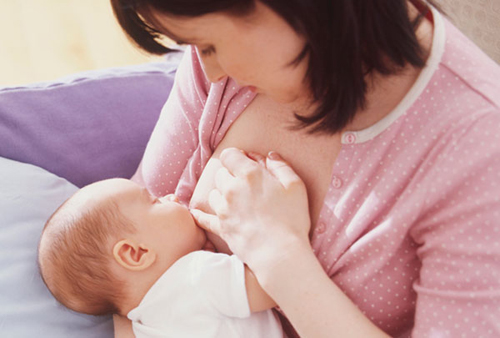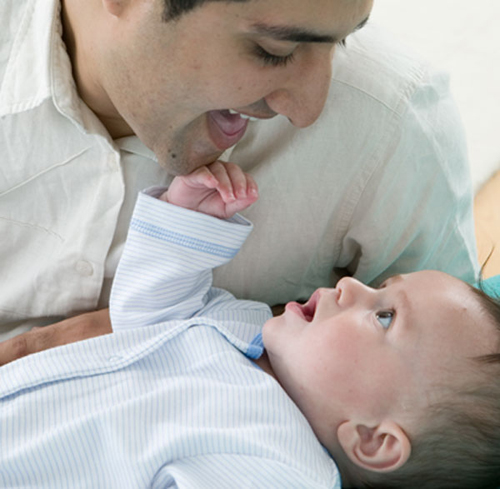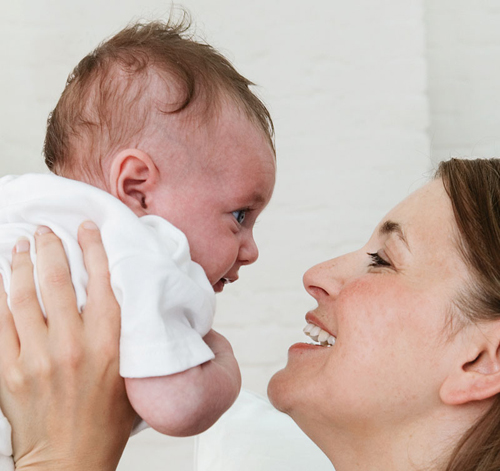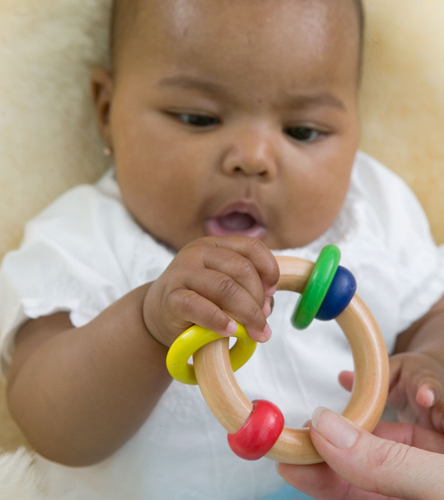| Q: |
Everyone is giving me advice about my baby. How do I tell them nicely to back off?
| | A: |
When you have a new baby it seems everyone is willing to offer
advice, whether you want it or not. Even complete strangers will
approach you to offer their suggestions for colic, crying, and all else
baby-related. There is no harm in listening to these well-meaning ideas,
but don’t feel under any obligation to try them out yourself. Simply
smile and thank the person, then decide yourself what is best for your
baby and yourself.
If the advice comes
from closer to home, perhaps from your mom or best friend, it can be
harder to handle. Some simple honesty should do the trick: Explain how
much you appreciate their help but that sometimes, when they’re giving
lots of advice, it feels like they don’t have confidence in you.
Reassure them that you will turn to them if you have a question.
|
| Q: |
I feel silly for always talking to my baby as if she understands. Am I wasting my breath?
| | A: |
You may get a few funny looks while you’re chatting away to your
new daughter, but you’re actually doing the right thing. Whether you
give a running commentary about what you’re doing, describe things
around her, or sing a lullaby, the more your baby hears your voice, the
better her ability to speak and listen in the coming years. Research has
found that the babies of chatty mothers had 131 more words in their
vocabulary by the age of 20 months compared to the children of quieter
mothers, so all that talking really does make a difference.
You may wonder if you
should be speaking in an adult tone or using the “sing-song” voice which
probably comes naturally to you. Called “parentese,” this is a musical
way of speaking using a high-pitched tone of voice combined with strong
facial expressions, long vowels, and short sentences. These features,
and the repetitive nature of “parentese,” promote your baby’s speech
more effectively than speaking in a normal adult voice. “Parentese”
should not be confused with baby talk, which might substitute “woof
woof” for “dog” or include nonsense words, and is less helpful for your
child’s developing speech.
|
| Q: |
How can I take the best care of my premature baby?
| | A: |
Caring for a premature baby brings feelings of love as well as
mixed emotions for many parents. It’s common to feel immensely grateful
that your baby has survived, yet anxious about meeting any additional
needs or wondering whether there will be long-term difficulties.
Keeping a watchful eye
on your child’s development is wise, so you’ll be quick to spot any
problems and get the help you need. What you’ll probably find is that
she’ll follow the same sequence of milestones and patterns as a
full-term baby and will have caught up with her peers by the time she is
two if there have been no other complications. To gauge how she’s
doing, check her development against her corrected rather than
chronological age. Her chronological age is measured from her date of
birth, while her corrected age is her time since birth minus the number
of weeks she was premature. So, at eight months old, if your child was
two months premature, her corrected age would be six months, and the
milestones she’s achieving will be closer to those associated with the
younger age.
Simply because of her
prematurity, your baby may be less responsive than you’d hoped for
during her first days and weeks. Her reactions will be milder when you
speak to her, touch her, and feed her. This is to be expected because
she’s less able to see, hear, and move her body in response to you.
However, she needs your input even more than a full-term baby as she has
to cope with an environment that, physically, she’s not quite ready
for. You can help her ability to bond with you, and her development, by
practicing kangaroo care.
This involves skin-to-skin contact, usually on your chest or belly,
just after the birth or within 24 hours. Ask the advice of hospital
staff about having skin-to-skin contact whenever possible.
|
| Q: |
I’ve heard baby boys and girls differ in their development. Is this true?
| | A: |
There are some differences in development between boys and girls,
but these tend to come out a little later, from toddlerhood onward. If
you have a little boy and a girl, when you compare your children’s first
years you’ll notice plenty of variety in their development. This is a
natural result of their being two distinct individuals, rather than an
effect of sex differences. Their separate personalities will make
themselves felt, and they’ll have their own habits and temperament,
whether it’s excitable, placid, alert, or easily overwhelmed. The latest
evidence shows that it is largely parental expectations of boys
compared to girls that affects our perception of their development.
Without realizing it is happening, boys and girls are seen differently
even from birth. For example, parents tend to describe girls as more
delicate and boys as stronger. Any small variation in development based
on sex is overridden at this early age by individual differences.
There is one
difference between boys and girls to be aware of: Researchers have found
that boys are more vulnerable if there are difficulties in family life,
such as parental conflict or depression. Reactions such as withdrawal,
sadness, or aggressive behavior will be more marked compared to girls
who tend to be less strongly affected and more resilient. It is not yet
clear why this gender difference happens. But keep in mind that if you
are feeling depressed or there are difficulties at home, getting help
will benefit your children, especially your son, as well as yourself.
|
| Q: |
Is it better to stick to a routine or play and feed on demand?
| | A: |
There has been much debate among parents and childcare
professionals on the topic of fixed daily regimes for babies compared to
a more “play it by ear” approach where the baby sets the schedule. In
reality, the ideal is a combination of routine and flexibility. Your
child will thrive when he has regular but not rigid times for play,
rest, visitors, bathing, and bedtime. Repeating a set sequence of events
each day will give him a sense that his world is safe and predictable.
It is just as vital, however, to respond to his basic needs for food,
rest, and comfort immediately rather than wait until his routine tells
you he should be hungry or sleepy. Reacting promptly with a cuddle or
feeding tells him you are looking out for him, and that it’s worth
communicating with you because when he does, you “read” his cries or
babbles and do something to help. Leaving babies to cry for long periods
teaches them that they can’t rely on the adults in their life, and also
releases cortisol, a stress hormone. Prolonged exposure to this hormone
in the long term can cause children to become sensitive to stress.
|
| Q: |
Recently I’ve noticed that the back of my baby’s head has become flattened. Why is this?
| | A: |
What you’re describing is known as Flathead Syndrome, also called
Positional Plagiocephaly, which may affect up to half of children these
days. This is probably the result of your baby spending a lot of time
in one position, usually lying on his back. You’ll be relieved to know
that this difficulty does not affect the development of his brain.
You can help to
relieve this flattening by increasing the time your baby spends playing
on his tummy. But don’t let him fall asleep like this: Babies should
always be put down to sleep on their backs to reduce the risk of sudden
infant death syndrome (SIDS). Try reducing his time in rigid seating,
such as a car seat. When he’s not traveling, take him out of his car
seat or stroller and carry him in a sling, hold him on your knee, or
give him tummy time. If he prefers to turn his head to one side only,
try to alternate his position when you feed him or place his most
interesting toys to one side to encourage turning. Special helmets or
bands are available that allow a baby’s skull to grow without pressure.
It is not yet clear whether these help or not, but some parents say
they’ve made a difference. For most children, the flattening eases
without any treatment, especially once they’re moving around. For a very
few infants this flattening is a result of a more serious condition, so
do consult a health professional to check this out.
|
Baby language Learning to understand
When my son was born, I
would hear his cries and feel like he was trying to tell me something
but I couldn’t understand what it was. It would be trial and error to
figure out if he needed to be fed, go to sleep, or if something else was
going on.
I tried to tune in to the
different sounds he made: Sometimes he’d be howling; other times his cry
was softer but still insistent. Over the first few days, to my
surprise, I got much better at matching his cry with what he wanted. My
confidence bounced back, and he seemed less frustrated because I wasn’t
changing his diaper when what he really needed was a nap.
NOTE
The more your baby hears your voice, the better her ability to speak and listen in the coming years
What’s going on Her brain and senses
Her brain
Your baby’s brain,
especially her higher brain (cortex), is developing at the fastest rate
it ever will. During this period of intense activity it is using twice
as much energy as it will in adulthood and by the time she is five years
old, 90 percent of brain development will be complete. All this
activity is not designed to increase the number of brain cells, of which
there are over 100 billion, but to create the connections between cells
through which information is passed and learning occurs. Your baby is
born with plenty of neural cells already connected, or hard-wired, so
she can perform essential tasks like turning her head, swallowing, and
sucking right away. These basic survival reflexes will quickly be
overridden by new neural connections, giving her increasing control over
her body.
Neural connections
All that happens to
your infant, everything she sees, each voice she hears or touch she
feels is reflected in the firing of neurons in her brain, which in turn,
forges connections between cells and creates learning. She will learn
most quickly those things that are repeated often, simply because
repeated use strengthens connections. When you talk and sing to her, the
neural pathways for language are reinforced, giving her a head start in
understanding speech and communication. Pathways that are seldom used
fall away and connections can be lost. This is the brain’s way of
ensuring that the strongest, most effective pathways dominate. You can
influence how your baby’s brain develops at every moment by giving her
plenty to look at, touch, and listen to in order to reinforce neural
connections. When you hold her confidently, go to her as soon as she
cries, and touch and speak to her with love, you are strengthening
pathways in her brain which tell her she is safe and can rely on you.
Her senses
Your baby will be alert
and turning toward sounds in her early days. At birth her hearing is
more highly developed than her sight (for adults the opposite applies)
and sight will become a more dominant sense than hearing as she grows
older. She can see high-contrast items more clearly, so black-and-white
toys and mobiles are good. A newborn focuses best at about 8–12 inches
(20–30 cm) or so, which is exactly the distance between her face and
yours if you cradle her in your arms, or when a mother breastfeeds.
At first, the pathways
in her brain for different senses are not separated out. For example,
when there is a loud noise she may see it as a disturbance of her vision
as well as hear it, so it’s no wonder she’s easily startled. This
joining of the senses is called synesthesia, meaning two or more senses
are mixed—for example, hearing a sound and also seeing it as a color. It
is not yet clear when the senses become separated; some say between two
and four months of age, while others suggest a little later in the
first year. For a tiny minority, between 1 in 100,000 and 1 in 25,000,
some senses continue to be joined, and this becomes permanent.
Your baby will be
born with a preference for sweet tastes over salty flavors. This
hard-wired favorite is designed for survival, giving her a built-in
appreciation for the sweet taste of breast milk. Her sense of smell is
developing rapidly at birth. If you breastfeed, she’ll be able to
recognize the smell of your breast milk compared to that of another
mother within a few days.
Reinforcing
Speaking and interacting
with your baby and holding her lovingly will all help to build pathways
in her brain, telling her she is secure.



Brain-building
Playing with toys such
as rattles helps develop neural connections, enhancing all aspects of
learning, including hand–eye coordination.

|